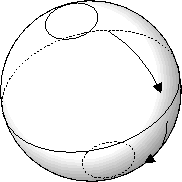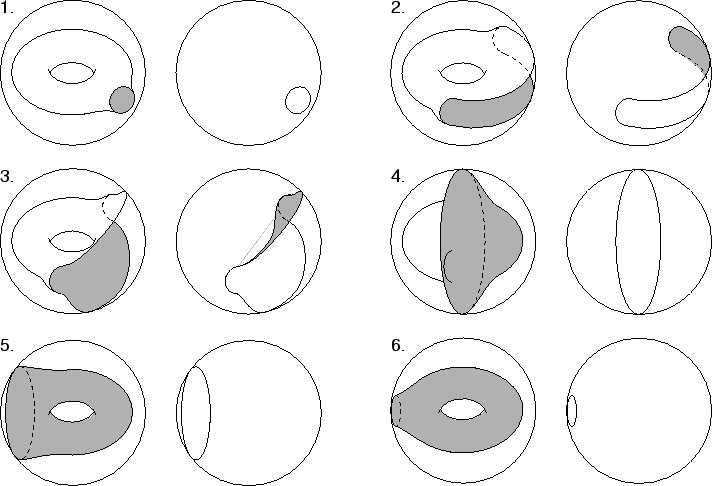From our two balls model, it is easy to see that we can shrink the equatorial
![]() inside
inside
![]() , until it is a small sphere surrounding the north pole or the south pole.
, until it is a small sphere surrounding the north pole or the south pole.
Let
![]() , and let
, and let
![]() such that
such that
![]() . Then varying
. Then varying ![]() in the range
in the range
![]() gives a continuous family of
gives a continuous family of
![]() inside
inside
![]() . When
. When
![]() or
or ![]() , the sphere is shrunk to a single point. When
, the sphere is shrunk to a single point. When ![]() is close to 1 or -1, it's a little sphere around either the north or south pole. When
is close to 1 or -1, it's a little sphere around either the north or south pole. When ![]() is near zero, it is nearly equatorial.
is near zero, it is nearly equatorial.
If we now consider the two regions into which the
![]() is divided by this moving
is divided by this moving
![]() , this might seem very similar to some process of turning the
, this might seem very similar to some process of turning the
![]() ``inside out.'' However, this is not quite correct. We might look at the
``inside out.'' However, this is not quite correct. We might look at the
![]() inside
inside
![]() at some point and label the two regions as ``inside'' and ``outside'' based on which region was smaller. We do this because we are used to Euclidean space, where the ``inside,'' of a closed region usually appears smaller, and the outside usually includes the point at infinity.
at some point and label the two regions as ``inside'' and ``outside'' based on which region was smaller. We do this because we are used to Euclidean space, where the ``inside,'' of a closed region usually appears smaller, and the outside usually includes the point at infinity.
However, the region inside the sphere is already finite, and so calling this process ``inverting,'' or swapping the ``inside'' and ``outside'' of
![]() inside
inside
![]() really doesn't make a whole lot of sense. All we can say is that we can distort
really doesn't make a whole lot of sense. All we can say is that we can distort
![]() inside
inside
![]() in such a way as to shrink one region down to a point while expanding another region from a point to the whole sphere.
in such a way as to shrink one region down to a point while expanding another region from a point to the whole sphere.
Following from this, we see that any closed surface inside
![]() can be ``inverted,'' by simply gluing
can be ``inverted,'' by simply gluing
![]() to a small region of the manifold, and then ``inverting'' this sphere.
to a small region of the manifold, and then ``inverting'' this sphere.
From now on I'll use the word ``inversion'' in the sphere to mean a process like this which apparently reverses the two regions in
![]() created by a dividing surface in
created by a dividing surface in
![]() .
.
Notice that
![]() and
and
![]() are identical manifolds. So we know, trivially, that we can invert
are identical manifolds. So we know, trivially, that we can invert
![]() inside
inside
![]() .
.

Notice also that we can embed the flat torus,
![]() , inside
, inside
![]() . To see this best, consider our space to be
. To see this best, consider our space to be
![]() . Then the sphere consists of all points
. Then the sphere consists of all points
![]() such that
such that
![]() , and the torus consists of all points
, and the torus consists of all points
![]() such that
such that
![]() .
.
Inside
![]() , this torus can be ``inverted,'' that is, it can be deformed in such a way so that (1) the generators of the torus are swapped, and (2) the apparent ``outside'' is swapped with the apparent ``inside.'' Here are a series of pictures to illustrate the second point; pictures showing the generators being swapped are in section 4.2.
, this torus can be ``inverted,'' that is, it can be deformed in such a way so that (1) the generators of the torus are swapped, and (2) the apparent ``outside'' is swapped with the apparent ``inside.'' Here are a series of pictures to illustrate the second point; pictures showing the generators being swapped are in section 4.2.

The important point to notice from this is that
![]() divides
divides
![]() into two regions, both of which are topologically equivalent to a filled
into two regions, both of which are topologically equivalent to a filled
![]() . It is by no means obvious that this is a general fact about
. It is by no means obvious that this is a general fact about
![]() inside
inside
![]() . Furthermore, we can ask whether there is any deeper structure behind this inversion, or whether it is merely a manifestation of the fact, noted above, that any manifold can be inverted inside of the sphere.
. Furthermore, we can ask whether there is any deeper structure behind this inversion, or whether it is merely a manifestation of the fact, noted above, that any manifold can be inverted inside of the sphere.
We know that any manifold can be inverted inside
![]() by gluing it to a sphere. If we know that
by gluing it to a sphere. If we know that
![]() in general can be embedded inside
in general can be embedded inside
![]() , then we will know that
, then we will know that
![]() can be inverted inside
can be inverted inside
![]() , by gluing the torus to a
, by gluing the torus to a
![]() and inverting that
and inverting that
![]() .
.
The proof is inductive. To begin with, we know that
![]() can be embedded in
can be embedded in
![]() , which can be stereographically projected to
, which can be stereographically projected to
![]() .
.
If, in general,
![]() can be embedded in
can be embedded in
![]() , then we can embed
, then we can embed
![]() in
in
![]() . Think of this simply as as a ``thickened'' or ``fattened'' torus. Next, we cross both with
. Think of this simply as as a ``thickened'' or ``fattened'' torus. Next, we cross both with ![]() , to get
, to get
![]() . Now, we can draw a little circle in
. Now, we can draw a little circle in ![]() to see that
to see that
![]() . And, of course,
. And, of course,
![]() . So
. So
![]() . Since
. Since
![]() can be embedded in
can be embedded in
![]() ,
,
![]() can be embedded in
can be embedded in
![]() as we can just project
as we can just project
![]() to
to
![]() via stereographic projection.
via stereographic projection.
So, in general,
![]() can be embedded and ``inverted'' inside
can be embedded and ``inverted'' inside
![]() . The next question is whether the neat symmetry of
. The next question is whether the neat symmetry of
![]() in
in
![]() generalizes as well. To do this we will need to look closer at the structure of
generalizes as well. To do this we will need to look closer at the structure of
![]() .
.